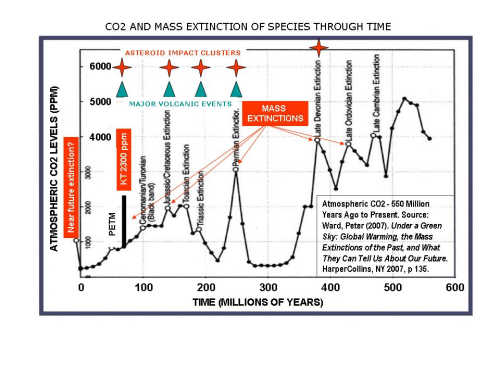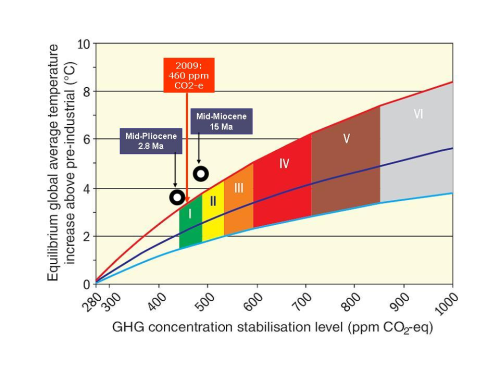
Figure 1. Atmospheric CO2 550 million years ago to the present. Source: Peter Ward (2007): Under a Green Sky (Harper Collins, NY 2007).
The release of more than 370 billion tons of carbon (GtC) from buried early biospheres, adding more than one half of the original carbon inventory of the atmosphere (~590GtC), as well as the depletion of vegetation, have triggered a fundamental shift in the state of the atmosphere (after Peter Ward, Under a Green Sky: Global Warming, the Mass Extinctions of the Past, and What They Can Tell Us About Our Future, HarperCollins). Raising atmospheric CO2 level at a rate of 2ppm/year, a pace unprecedented in the geological record, with the exception of the effects of CO2 released from craters excavated by large asteroid impacts, the deleterious effects of pollution and deforestation have reached a geological dimension, tracking towards conditions which existed on Earth in the mid-Pliocene, about 2.8 million years ago.
Advertisement
Lost all too often in the climate debate is an appreciation of the delicate balance between the physical and chemical state of the atmosphere-ocean-land system and the evolving biosphere, which controls the emergence, survival and demise of species, including humans. By contrast to Venus, with its thick blanket of CO2 and sulphur dioxide greenhouse atmosphere, exerting extreme pressure (90 bars) at the surface, or Mars with its thin (0.01 bar) CO2 atmosphere, the presence in the Earth’s atmosphere of trace concentrations of greenhouse gases (CO2, methane, nitric oxides, ozone) modulates surface temperatures in the range of -89 and +57.7 degrees Celsius and a mean of 14 degrees Celsius, allowing the presence of liquid water and thereby of life.
Forming a thin breathable veneer only slightly more than 1,000th the diameter of Earth, and evolving both gradually as well as through major perturbations with time, the Earth’s atmosphere acts as a lungs of the biosphere, allowing an exchange of carbon gases and oxygen with plants and animals, which in turn affect the atmosphere, for example through release of methane and photosynthetic oxygen.
CO2 is 28 times more soluble in water than is oxygen. Above critical threshold CO2 becomes toxic for certain organisms. Marine organisms are more sensitive to changes in CO2 levels than are terrestrial organisms. Excess CO2 reduces the ability of respiratory pigments to oxygenate tissues, and makes body fluids more acidic, thereby hampering the production of carbonate hard parts like shells. Relatively modest but sustained increases in CO2 concentrations hamper the synthesis of proteins, reduce fertilisation rates, and produce deformities in calcareous hard parts. The observed pattern of marine extinctions is consistent with hypercapnia (excessive levels of CO2), with related extinction events.
When the concentration of CO2 in the atmosphere rises above a critical threshold, climate shifts to a different state. Any significant increase in the level of carbon gases triggers powerful feedbacks. These include ice melt/warm water interaction, decline of ice reflection (albedo) and increase in infrared absorption by exposed water. Further release of CO2 from the oceans and from drying and burning vegetation shifts global climate zones towards the poles, warms the oceans and induces ocean acidification.
The essential physics of the infrared absorption/emission resonance of greenhouse molecules is indicated by observations in nature and laboratory studies, as portrayed in the relations between atmospheric CO2 and mean global temperature projections (Figure 2).

Advertisement
Figure 2. The relations between atmospheric CO2-equivalent (including the radiative forcing of methane) and mean global temperature, according to Charney’s climate sensitivity parameter (Hansen et al., 2007, 2008) (IPCC-2007). Circles mark new paleoclimate estimates of atmospheric conditions in the mid-Pliocene (2.8 million years ago) and the mid-Miocene (15 million years ago), with implications to current climate trajectories.
During most of Earth history the oxygen-poor composition of the atmosphere resulted in dominance of reduced carbon species in the air and the oceans, including methane and carbon monoxide, allowing mainly algae and bacteria to exist in the oceans. It is commonly held that, about 0.7 billion years ago, in the wake of the Marinoan glaciation (so-called “Snowball Earth”), oxygenation of low-temperature water allowed development of new oxygen-binding proteins and thereby of multicellular animals, followed by development of a rich variety of organisms - the “Cambrian explosion”.
Discuss in our Forums
See what other readers are saying about this article!
Click here to read & post comments.
55 posts so far.